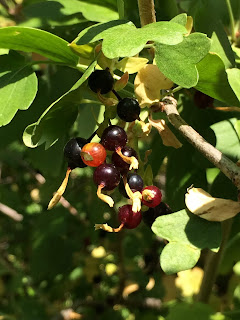Currant Appeal
by Vicky Barney
The berry shrubs are loaded with fruit this year, most noticeably the serviceberry, whose branches are drooping under the weight. In the wild and in my yard, I’m looking forward to watching the berries disappear and will be paying particular attention to my currants.
 |
| Golden Currant |
Currants (Ribes spp.) are deciduous shrubs with 3-5 lobed leaves and edible tart fruit historically used by Native Americans for food and medicinal purposes. In my yard, two shrubs have the distinctive leaves and berries, and similar looking arching branches. Their pea sized berries are growing in small clusters, each with a “pigtail” which is the remnant of its flower. Both shrubs are thorn less, drought tolerant, and, to date, of no interest to deer, moose, or bear. But the shrubs have some differences that lead me to think they are different varieties of currant.
On the east side of my yard, a small currant shrub is growing. About 3 feet in size, it is has pretty bright green 5 lobed leaves and arching branches. The spring flowers are inconspicuous but the berries are beautiful this time of year: bright red and clustered. They are also tasteless. I believe the shrub is a variety of the non-native Red currant (Ribes rubrum).
 |
| Red Currant |
Red currant is native to Europe and has been widely cultivated, both for fruit production and for landscaping purposes. It prefers cool soil temperatures with full sun and fertile loamy soil. My red currant is planted in a partly sunny area and is growing at a pleasant pace. It might produce flavorful berries if the shrub received more sunshine, water, and fertilizer, or it may be an ornamental variety with berries designed for looks rather than taste.
On the west side of my yard, the currant shrub is much larger (over 6 feet tall). It produced numerous fragrant, trumpet shaped yellow flowers in mid-May, providing early season food for pollinators. I believe it is Golden currant (Ribes aureum), a native to most of North America. Once the flowers faded, the shrub blended into the landscape with its bright green 3 lobed leaves. Inconspicuous berries appeared recently, orange at first and then turning black. The berries are quite tart and are disappearing, likely feeding the birds.
 |
| Golden Currant |
Golden currant prefers well drained soil in sun to part shade. My shrub is situated on a slope that receives midday sun and very little water. For a time, I aggressively pruned the sprawling shrub to allow the sun to shine on other plants. It responded well to the pruning and became more attractive. In fact, some currants grow better with regular pruning of older branches. I also discovered the shrub spreads by rhizomes, sending up shoots in the neighborhood and forcing me to continually evaluate the size of my currant “patch.”
In our area, the Red currant is a more attractive and easier shrub to grow, but it appears to have no wildlife visitors – no pollinators and no one eating the berries. Conversely, the native Golden currant, with its early flowers and little tart berries, has been humming with activity and loses berries every day. For that reason, periodic pruning and keeping its spread in check is worth the effort, and watching both shrubs over the next few months to see who comes to visit will be quite interesting.
Vicky Barney gardens for wildlife and is a member of the Master Gardener Class of 2011.



Komentar
Posting Komentar